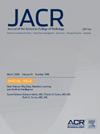Measuring Health-Related Social Risks in a Lung Cancer Screening Cohort
IF 5.1
3区 医学
Q1 RADIOLOGY, NUCLEAR MEDICINE & MEDICAL IMAGING
引用次数: 0
Abstract
Objective
To evaluate the feasibility and limitations of measuring health-related social risks (HRSRs) affecting individuals in a lung cancer screening (LCS) cohort from multiple data sources.
Methods
A single-institution study analyzed data from 227 participants in a pragmatic LCS trial in west and southwest Philadelphia. HRSRs were assessed using three approaches: (1) electronic health records (EHRs) capturing individual-level social risks (eg, financial strain, housing stability); (2) neighborhood-level analysis using a modified Yost index to determine socio-economic status; and (3) semistructured interviews with 15 participants to identify barriers and facilitators to LCS adherence.
Results
EHR data revealed financial strain and housing instability as the most documented HRSRs, although missing data ranged from 64% to 69%. Neighborhood-level analysis showed participants had lower socio-economic status compared with their broader communities, with Yost index scores of 1.28 (west Philadelphia) and 1.20 (southwest Philadelphia). Interviews highlighted limited knowledge of LCS (87% unaware before clinician referral), reliance on public or supplemental transportation, and overall trust in health care providers. Transportation was not a significant reported barrier to LCS adherence.
Discussion
This study demonstrates the promise and limitations of EHR data, neighborhood-level data, and patient interviews to assess HRSRs. Although EHRs provided limited and inconsistent data, interviews captured granular individual experiences, and neighborhood-level analysis contextualized socio-economic influences. Comprehensive and consistent data collection across multiple sources is critical in understanding HRSRs experienced by individuals.
测量肺癌筛查队列中与健康相关的社会风险
目的:评价从多个数据源测量影响肺癌筛查(LCS)队列个体的健康相关社会风险(HRSRs)的可行性和局限性。方法:一项单机构研究分析了费城西部和西南部一项实用LCS试验中227名参与者的数据。采用三种方法对hrsr进行评估:(1)电子健康记录(EHRs)捕捉个人层面的社会风险(例如,财务压力、住房稳定性);(2)利用改进的Yost指数进行社区水平分析,确定社会经济地位;(3)与15名参与者进行半结构化访谈,以确定遵守LCS的障碍和促进因素。结果:电子病历数据显示,财务紧张和住房不稳定是记录最多的hrsr,尽管缺失数据范围为64%至69%。社区层面的分析显示,与更广泛的社区相比,参与者的社会经济地位较低,约斯特指数得分为1.28(费城西部)和1.20(费城西南部)。访谈强调了LCS知识有限(87%的人不知道在临床医生转诊前),依赖公共交通或辅助交通,以及对卫生保健提供者的总体信任。据报道,交通并不是LCS依从性的显著障碍。讨论:本研究展示了电子病历数据、社区水平数据和患者访谈评估hrsr的前景和局限性。尽管电子病历提供了有限且不一致的数据,但访谈捕获了细粒度的个人经历,并且社区层面的分析将社会经济影响背景化。跨多个来源的全面和一致的数据收集对于理解个人经历的hrsr至关重要。
本文章由计算机程序翻译,如有差异,请以英文原文为准。
求助全文
约1分钟内获得全文
求助全文
来源期刊

Journal of the American College of Radiology
RADIOLOGY, NUCLEAR MEDICINE & MEDICAL IMAGING-
CiteScore
6.30
自引率
8.90%
发文量
312
审稿时长
34 days
期刊介绍:
The official journal of the American College of Radiology, JACR informs its readers of timely, pertinent, and important topics affecting the practice of diagnostic radiologists, interventional radiologists, medical physicists, and radiation oncologists. In so doing, JACR improves their practices and helps optimize their role in the health care system. By providing a forum for informative, well-written articles on health policy, clinical practice, practice management, data science, and education, JACR engages readers in a dialogue that ultimately benefits patient care.
 求助内容:
求助内容: 应助结果提醒方式:
应助结果提醒方式:


